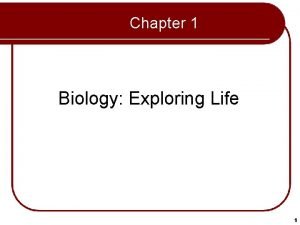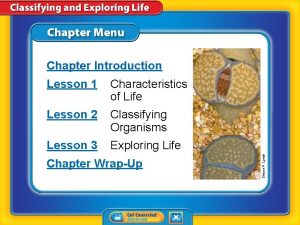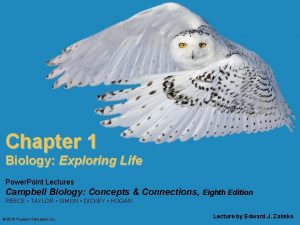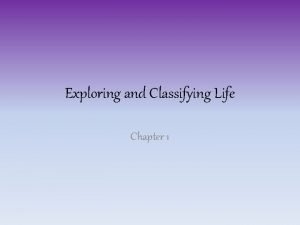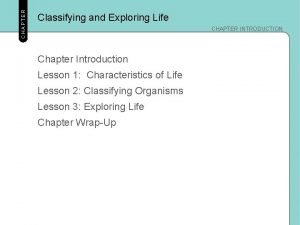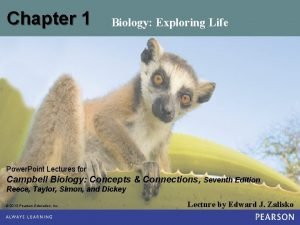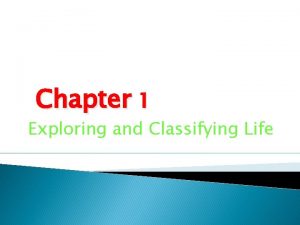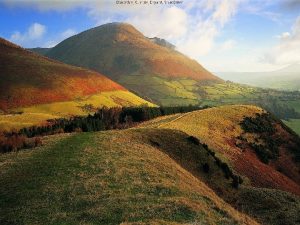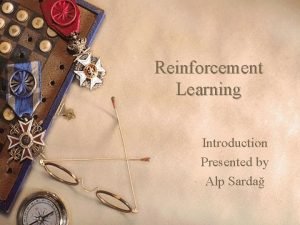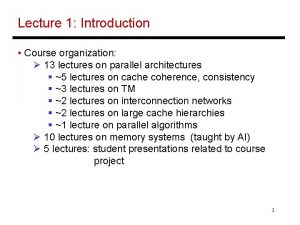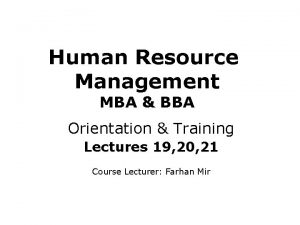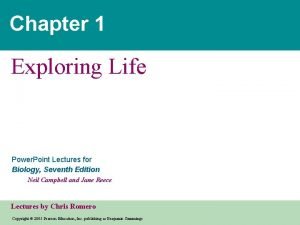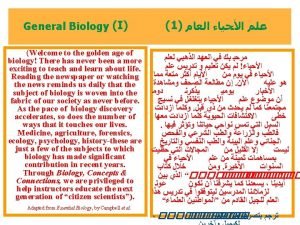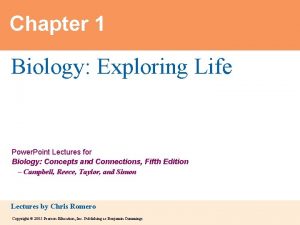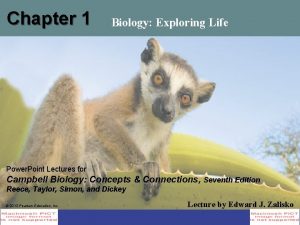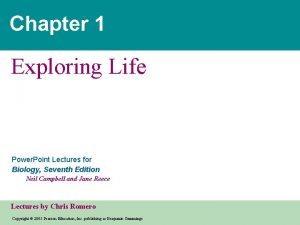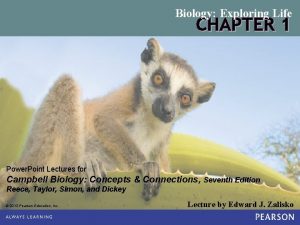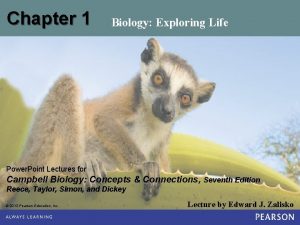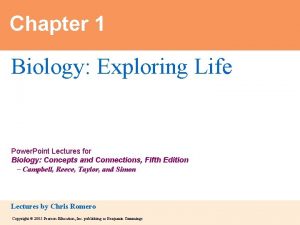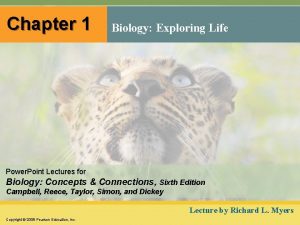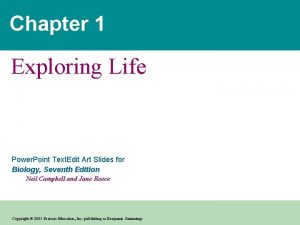Chapter 1 Exploring Life Power Point Lectures for















































- Slides: 47

Chapter 1 Exploring Life Power. Point Lectures for Biology, Seventh Edition Neil Campbell and Jane Reece Lectures by Chris Romero Copyright © 2005 Pearson Education, Inc. publishing as Benjamin Cummings

• Overview: Biology’s Most Exciting Era • Biology – Is the scientific study of life – The phenomenon we call life defies a simple, one-sentence definition • We recognize life – By what living things do Copyright © 2005 Pearson Education, Inc. publishing as Benjamin Cummings

• Some properties of life (a) Order (d) Regulation (b) Evolutionary adaptation (c) Response to the environment (e) Energy processing (f) Growth and development Figure 1. 2 Copyright © 2005 Pearson Education, Inc. publishing as Benjamin Cummings (g) Reproduction

• Concept 1. 1: Biologists explore life from the microscopic to the global scale • The study of life – Extends from the microscope scale of molecules and cells to the global scale of the entire living planet Copyright © 2005 Pearson Education, Inc. publishing as Benjamin Cummings

A Hierarchy of Biological Organization • The hierarchy of life – Extends through many levels of biological organization Copyright © 2005 Pearson Education, Inc. publishing as Benjamin Cummings

• From the biosphere to organisms 1 The biosphere Figure 1. 3 Copyright © 2005 Pearson Education, Inc. publishing as Benjamin Cummings

• From cells to molecules 9 Organelles 1 µm Cell 8 Cells Atoms 10 µm 7 Tissues 50 µm 6 Organs and organ systems Figure 1. 3 Copyright © 2005 Pearson Education, Inc. publishing as Benjamin Cummings 10 Molecules

A Closer Look at Ecosystems • Each organism – Interacts with its environment • Both organism and environment – Are affected by the interactions between them Copyright © 2005 Pearson Education, Inc. publishing as Benjamin Cummings

Ecosystem Dynamics • The dynamics of any ecosystem include two major processes – Cycling of nutrients, in which materials acquired by plants eventually return to the soil – The flow of energy from sunlight to producers to consumers Copyright © 2005 Pearson Education, Inc. publishing as Benjamin Cummings

Energy Conversion • Activities of life – Require organisms to perform work, which depends on an energy source • The exchange of energy between an organism and its surroundings – Often involves the transformation of one form of energy to another Copyright © 2005 Pearson Education, Inc. publishing as Benjamin Cummings

• Energy flows through an ecosystem – Usually entering as sunlight and exiting as heat Sunlight Ecosystem Producers (plants and other photosynthetic organisms) Heat Chemical energy Consumers (including animals) Figure 1. 4 Copyright © 2005 Pearson Education, Inc. publishing as Benjamin Cummings Heat

A Closer Look at Cells • The cell – Is the lowest level of organization that can perform all activities required for life Figure 1. 5 Copyright © 2005 Pearson Education, Inc. publishing as Benjamin Cummings 25 µm

The Cell’s Heritable Information • Cells contain chromosomes made partly of DNA, the substance of genes – Which program the cells’ production of proteins and transmit information from parents to offspring Sperm cell Nuclei containing DNA Egg cell Fertilized egg with DNA from both parents Figure 1. 6 Copyright © 2005 Pearson Education, Inc. publishing as Benjamin Cummings Embyro’s cells with copies of inherited DNA Offspring with traits inherited from both parents

• The molecular structure of DNA – Accounts for its information-rich nature Nucleus DNA Cell Nucleotide Figure 1. 7 (a) DNA double helix. This model shows each atom in a segment of DNA. Made up of two long chains of building blocks called nucleotides, a DNA molecule takes the three-dimensional form of a double helix. Copyright © 2005 Pearson Education, Inc. publishing as Benjamin Cummings A C T A C C G T A (b) Single strand of DNA. These geometric shapes and letters are simple symbols for the nucleotides in a small section of one chain of a DNA molecule. Genetic information is encoded in specific sequences of the four types of nucleotides (their names are abbreviated here as A, T, C, and G).

Two Main Forms of Cells • All cells share certain characteristics – They are all enclosed by a membrane – They all use DNA as genetic information • There are two main forms of cells – Eukaryotic – Prokaryotic Copyright © 2005 Pearson Education, Inc. publishing as Benjamin Cummings

• Eukaryotic cells – Are subdivided by internal membranes into various membrane-enclosed organelles Copyright © 2005 Pearson Education, Inc. publishing as Benjamin Cummings

• Prokaryotic cells – Lack the kinds of membrane-enclosed organelles found in eukaryotic cells EUKARYOTIC CELL PROKARYOTIC CELL DNA Membrane (no nucleus) Membrane Cytoplasm Organelles Figure 1. 8 Nucleus (contains DNA) Copyright © 2005 Pearson Education, Inc. publishing as Benjamin Cummings 1 µm

• Concept 1. 2: Biological systems are much more than the sum of their parts • A system – Is a combination of components that form a more complex organization • Due to increasing complexity – New properties emerge with each step upward in the hierarchy of biological order Copyright © 2005 Pearson Education, Inc. publishing as Benjamin Cummings

The Power and Limitations of Reductionism • Reductionism – Involves reducing complex systems to simpler components that are more manageable to study • In feedback regulation – The output, or product, of a process regulates that very process Copyright © 2005 Pearson Education, Inc. publishing as Benjamin Cummings

Feedback Regulation in Biological Systems • A kind of supply-and-demand economy – Applies to some of the dynamics of biological systems Copyright © 2005 Pearson Education, Inc. publishing as Benjamin Cummings

• In negative feedback – An accumulation of an end product slows the process that produces that product A Negative feedback Enzyme 1 B A Enzyme 1 B Enzyme 2 C C Enzyme 3 D D D D D Figure 1. 11 Copyright © 2005 Pearson Education, Inc. publishing as Benjamin Cummings D

• In positive feedback – The end product speeds up production W W Enzyme 4 Positive feedback X X Enzyme 5 Y Y Enzyme 6 Z Z Figure 1. 12 Enzyme 6 Z Z Copyright © 2005 Pearson Education, Inc. publishing as Benjamin Cummings Z Z Z

• Concept 1. 3: Biologists explore life across its great diversity of species • Diversity is a hallmark of life • Taxonomy – Is the branch of biology that names and classifies species according to a system of broader and broader groups Copyright © 2005 Pearson Education, Inc. publishing as Benjamin Cummings

• Classifying life Species Genus Family Order Class Phylum Ursus americanus (American black bear) Ursus Ursidae Carnivora Mammalia Chordata Animalia Figure 1. 14 Copyright © 2005 Pearson Education, Inc. publishing as Benjamin Cummings Eukarya Kingdom Domain

The Three Domains of Life • At the highest level, life is classified into three domains – Bacteria – Archaea – Eukarya Copyright © 2005 Pearson Education, Inc. publishing as Benjamin Cummings

• Domain Bacteria and domain Archaea – Consist of prokaryotes • Domain Eukarya, the eukaryotes – Includes the various protist kingdoms and the kingdoms Plantae, Fungi, and Animalia Copyright © 2005 Pearson Education, Inc. publishing as Benjamin Cummings

• Life’s three domains Bacteria are the most diverse 4 µm and widespread prokaryotes and are now divided among multiple kingdoms. Each of the rod-shaped structures in this photo is a bacterial cell. DOMAIN ARCHAEA Figure 1. 15 Many of the prokaryotes known 0. 5 µm as archaea live in Earth‘s extreme environments, such as salty lakes and boiling hot springs. Domain Archaea includes multiple kingdoms. The photo shows a colony composed of many cells. Protists (multiple kingdoms) 100 µm are unicellular eukaryotes and their relatively simple multicellular relatives. Pictured here is an assortment of protists inhabiting pond water. Scientists are currently debating how to split the protists into several kingdoms that better represent evolution and diversity. Kingdom Plantae consists of multicellula eukaryotes that carry out photosynthesis, the conversion of light energy to food. Kindom Fungi is defined in part by the nutritional mode of its members, such as this mushroom, which absorb nutrientsafter decomposing organic material. Kindom Animalia consists of multicellular eukaryotes that ingest other organisms. Copyright © 2005 Pearson Education, Inc. publishing as Benjamin Cummings

Unity in the Diversity of Life • As diverse as life is – There is also evidence of remarkable unity 15 µm 1. 0 µm Cilia of Paramecium. The cilia of Paramecium propel the cell through pond water. 5 µm Figure 1. 16 Cross section of cilium, as viewed with an electron microscope Cilia of windpipe cells. The cells that line the human windpipe are equipped with cilia that help keep the lungs clean by moving a film of debris-trapping mucus upward. Copyright © 2005 Pearson Education, Inc. publishing as Benjamin Cummings

• Concept 1. 4: Evolution accounts for life’s unity and diversity • The history of life – Is a saga of a changing Earth billions of years old Figure 1. 17 Copyright © 2005 Pearson Education, Inc. publishing as Benjamin Cummings

• The evolutionary view of life – Came into sharp focus in 1859 when Charles Darwin published On the Origin of Species by Natural Selection Figure 1. 18 Copyright © 2005 Pearson Education, Inc. publishing as Benjamin Cummings

• The Origin of Species articulated two main points – Descent with modification – Natural selection Figure 1. 19 Copyright © 2005 Pearson Education, Inc. publishing as Benjamin Cummings

Natural Selection • Darwin proposed natural selection – As the mechanism for evolutionary adaptation of populations to their environments Population of organisms Hereditary variations Overproduction and struggle for existence Differences in reproductive success Figure 1. 20 Evolution of adaptations in the population Copyright © 2005 Pearson Education, Inc. publishing as Benjamin Cummings

• Natural selection is the evolutionary process that occurs – When a population’s heritable variations are exposed to environmental factors that favor the reproductive success of some individuals over others 1 Populations with varied inherited traits 2 Elimination of individuals with certain traits. 3 Reproduction of survivors. Figure 1. 21 4 Increasing frequency of traits that enhance survival and reproductive success. Copyright © 2005 Pearson Education, Inc. publishing as Benjamin Cummings

• The products of natural selection – Are often exquisite adaptations of organisms to the special circumstances of their way of life and their environment Figure 1. 22 Copyright © 2005 Pearson Education, Inc. publishing as Benjamin Cummings

The Tree of Life • Many related organisms – Have very similar anatomical features, adapted for their specific ways of life • Such examples of kinship – Connect life’s “unity in diversity” to Darwin’s concept of “descent with modification” Copyright © 2005 Pearson Education, Inc. publishing as Benjamin Cummings

• Darwin proposed that natural selection – Could enable an ancestral species to “split” into two or more descendant species, resulting in a “tree of life” Large ground finch Large cactus ground finch Small ground finch Large tree finch Geospiza Camarhynchus Green Gray Geospiza magnirostris psitacula Medium warbler Sharp-beaked fuliginosa Woodpecker Geospiza Medium finch tree finch ground finch conirostris ground finch Certhidea Geospiza. Cactus Cactospiza Camarhynchus olivacea fusca difficilis ground finch pauper pallida Geospiza Mangrove Small tree finch fortis Geospiza Camarhynchus Cactospiza scandens parvulus heliobates Vegetarian Cactus flower Seed eater finch eater Platyspiza crassirostris Insect eaters Ground finches Figure 1. 23 Copyright © 2005 Pearson Education, Inc. publishing as Benjamin Cummings Tree finches Bud eater Warbler finches Common ancestor from South American mainland

• Each species is on a twig of a branching tree of life – Extending back in time through ancestral species more and more remote • All of life – Is connected through its long evolutionary history Copyright © 2005 Pearson Education, Inc. publishing as Benjamin Cummings

• Concept 1. 5: Biologists use various forms of inquiry to explore life • At the heart of science is inquiry – A search for information and explanation, often focusing on specific questions • Biology blends two main processes of scientific inquiry – Discovery science – Hypothesis-based science Copyright © 2005 Pearson Education, Inc. publishing as Benjamin Cummings

Discovery Science • Discovery science – Describes natural structures and processes as accurately as possible through careful observation and analysis of data Copyright © 2005 Pearson Education, Inc. publishing as Benjamin Cummings

Types of Data • Data – Are recorded observations – Can be quantitative or qualitative Figure 1. 24 Copyright © 2005 Pearson Education, Inc. publishing as Benjamin Cummings

Induction in Discovery Science • In inductive reasoning – Scientists derive generalizations based on a large number of specific observations Copyright © 2005 Pearson Education, Inc. publishing as Benjamin Cummings

Hypothesis-Based Science • In science, inquiry that asks specific questions – Usually involves the proposing and testing of hypothetical explanations, or hypotheses Copyright © 2005 Pearson Education, Inc. publishing as Benjamin Cummings

The Role of Hypotheses in Inquiry • In science, a hypothesis – Is a tentative answer to a well-framed question, an explanation on trial – Makes predictions that can be tested Copyright © 2005 Pearson Education, Inc. publishing as Benjamin Cummings

Deduction: The “If…then” Logic of Hypothesis-Based Science • In deductive reasoning – The logic flows from the general to the specific • If a hypothesis is correct – Then we can expect a particular outcome • A scientific hypothesis must have two important qualities – It must be testable – It must be falsifiable Copyright © 2005 Pearson Education, Inc. publishing as Benjamin Cummings

Designing Controlled Experiments • Experiments must be designed to test – The effect of one variable by testing control groups and experimental groups in a way that cancels the effects of unwanted variables Copyright © 2005 Pearson Education, Inc. publishing as Benjamin Cummings

• Concept 1. 6: A set of themes connects the concepts of biology • Underlying themes – Provide a framework for understanding biology Copyright © 2005 Pearson Education, Inc. publishing as Benjamin Cummings

• Eleven themes that unify biology Table 1. 1 Copyright © 2005 Pearson Education, Inc. publishing as Benjamin Cummings
 Power system lectures
Power system lectures Images
Images Draw the power triangle
Draw the power triangle Power bi power point
Power bi power point Point point power
Point point power Classifying and exploring life lesson 1 answer key
Classifying and exploring life lesson 1 answer key Connecting the concepts: exploring life
Connecting the concepts: exploring life Exploring and classifying life answer key
Exploring and classifying life answer key Classifying and exploring life
Classifying and exploring life Connecting the concepts: exploring life
Connecting the concepts: exploring life Exploring and classifying life
Exploring and classifying life Rick trebino lectures
Rick trebino lectures Neonatology lectures
Neonatology lectures Data mining lectures
Data mining lectures Advanced medicinal chemistry
Advanced medicinal chemistry Orthopedic ppt lectures
Orthopedic ppt lectures Ludic space
Ludic space Software project management lectures
Software project management lectures Cell and molecular biology lectures
Cell and molecular biology lectures Radio astronomy lectures
Radio astronomy lectures Dr sohail lectures
Dr sohail lectures Utilities and energy lecture
Utilities and energy lecture Web engineering lectures ppt
Web engineering lectures ppt How to get the most out of lectures
How to get the most out of lectures Frcr physics lectures
Frcr physics lectures Heel effect
Heel effect Cs106b lectures
Cs106b lectures Guyton physiology lectures
Guyton physiology lectures What is aerodynamics
What is aerodynamics Theory of translation lectures
Theory of translation lectures What is text linguistics
What is text linguistics Translation 1
Translation 1 Digital logic design lectures
Digital logic design lectures Kurose
Kurose Hegel three forms of art
Hegel three forms of art Nuclear medicine lectures
Nuclear medicine lectures Gpoint c++
Gpoint c++ Cdeep lectures
Cdeep lectures Oral communication 3 lectures text
Oral communication 3 lectures text C programming lectures
C programming lectures Haematology lectures
Haematology lectures Bureau of lectures
Bureau of lectures Trend lectures
Trend lectures Theory of translation lectures
Theory of translation lectures Reinforcement learning lectures
Reinforcement learning lectures 13 lectures
13 lectures Reinforcement learning lectures
Reinforcement learning lectures Bba lectures
Bba lectures

